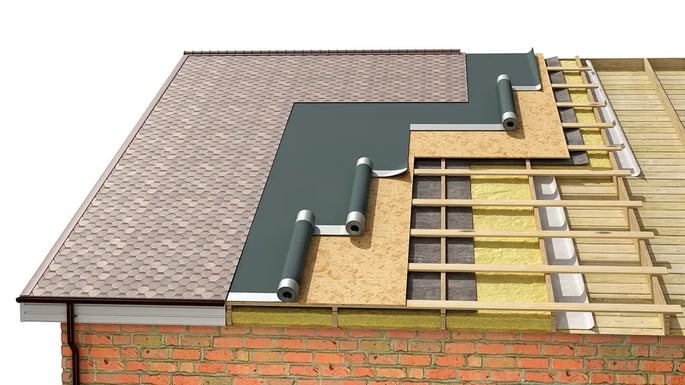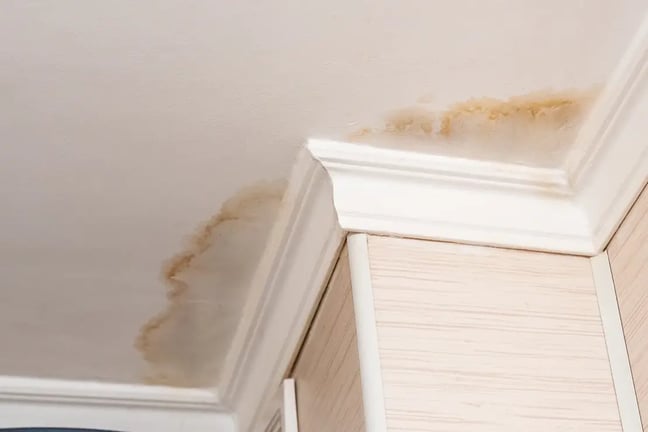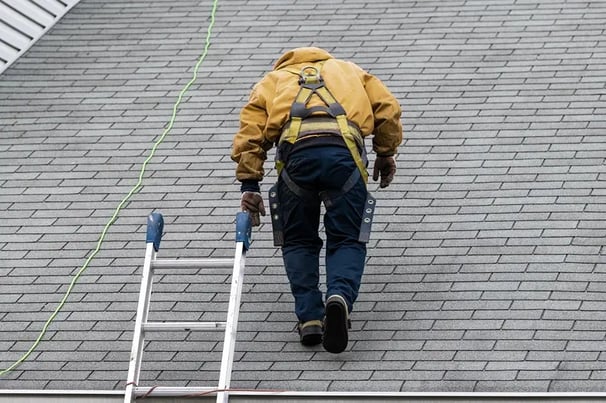The last thing you want to come home to at the end of a long day is water coming through your ceiling.
But sometimes, it happens.
Roofing leaks happen to almost every homeowner at some point, and the costs to fix them vary widely based on several factors.
In this article, we’ll walk you through the key elements that determine how much you can expect to pay to repair a roof leak. By the end, you'll have a clear understanding of what goes into the cost and what to anticipate if you ever find yourself staring at a water spot on your ceiling.
Average Cost to Repair a Roof Leak
While it’s difficult to provide an exact figure without inspecting the roof, let's look at some national averages to give you a sense of what to expect.
National Averages
The typical cost to repair a roof leak ranges from $150 to $1,500. The national average for most standard roof leak repairs lands around $400 to $600. However, the price can vary depending on the severity of the leak, the materials used, and the complexity of the repair. Small repairs, such as replacing a few damaged shingles, will fall on the lower end of the spectrum, while deeper issues, like water damage to the structure, can drive costs up into the thousands.
7 Factors That Affect the Cost of a Roof Repair
To get a better sense of how much your repair might cost, let's talk about 7 factors that will influence the price:
1. Roof Pitch
A roof with a steep pitch is harder to work on. It requires special safety equipment like harnesses or scaffolding, which increases labor costs. Steeper roofs also pose more of a safety risk to roofing contractors, and this additional effort will raise the overall price.
2. Extent of the Damage
The severity of the roof leak plays a crucial role in determining the final repair cost.
- Minor Leaks:Small leaks, such as those caused by a few damaged shingles or a small crack in the flashing, are relatively inexpensive to repair. In these cases, repairs may only cost between $150 and $400, depending on how quickly the issue is addressed and how easy the damage is to access . These repairs typically involve replacing or patching a small area.
- Major Leaks:Larger leaks that have caused structural damage or have been left unchecked for a long time will be more expensive to fix. If the leak has led to rotting wood, damaged insulation, or mold buildup, you’re looking at a much bigger repair job. Major leaks can require replacing damaged sections of the roof, treating water damage inside your home, and possibly even rebuilding parts of the structure. In such cases, repair costs can reach $1,000 to $4,000 or more, depending on the extent of the damage.
3. Roof Material Type
The material your roof is made from also has a big impact on how much it will cost to repair a leak.
- Asphalt Shingles: As the most common roofing material, asphalt shingles are typically the most affordable to repair. Minor repairs for asphalt roofs generally cost between $200 and $400 . The materials are easy to source and replace, making them budget-friendly for small leak repairs.
- Metal Roofs: Metal roofs are more durable but also more expensive to repair. The cost to repair a metal roof typically ranges from $500 to $1,500, depending on the size of the damage. Metal roofs require more specialized tools and labor, which raises the cost .
- Tile or Slate Roofs:Premium materials like tile and slate are significantly more expensive to repair. Fixing leaks on these types of roofs can cost up to $2,000 or more due to the delicate nature of the materials and the specialized labor required . Additionally, tiles or slates may need to be custom-made or specially ordered, which adds to the cost.
4. Location of the Leak
The physical location of the leak on your roof can dramatically affect repair costs.
- Hard-to-Reach Areas:If the leak is in a challenging location, such as near a chimney, vent, or in a high corner, it will take longer to access and repair. This requires more labor and potentially specialized tools, increasing the overall cost. Roofers may need to construct scaffolding or use specialized safety equipment, which can add $200 to $500 to the repair bill .
- Ease of Access:On the other hand, leaks in easily accessible areas, like the flat portions of the roof or low-pitched sections, are less labor-intensive. Repairs in these areas usually cost less because the contractor can quickly reach the problem spot without additional equipment.
5. Labor Costs
Labor is another major factor in the cost of roof leak repairs, and rates can vary depending on your location and the contractor’s expertise.
- Roofing Professionals:Roofing contractors typically charge an hourly rate ranging from $45 to $75 per hour, depending on their experience and the complexity of the repair . For more intricate jobs, such as repairing leaks in difficult-to-access areas or on premium materials like tile or metal, labor costs may be higher.
- Local Pricing Differences:Labor rates can also vary based on your geographic location. In urban areas, where demand for roofing contractors is higher, you can expect to pay more for labor. In contrast, rural areas or regions with lower living costs may see lower hourly rates. Keep in mind that roofing companies may also charge a minimum fee, typically around $150 to $300, even for small jobs .
6. Damage to Insulation, Ceilings, or Drywall

When water penetrates your roof, it doesn’t just stay confined to the surface. Over time, water can seep into the layers beneath your shingles, damaging the insulation, attic, drywall, and even structural beams.
- Damage Beneath the Surface:If a roof leak goes unchecked for too long, water may soak through the roof deck and into the attic or living space below. This can cause issues with the insulation, reducing its effectiveness and leading to higher energy bills. Insulation replacement alone can cost between $1 to $4.50 per square foot , depending on the type and extent of the water damage.
Beyond insulation, water can also damage the drywall or ceilings, causing them to warp or sag. Replacing drywall typically costs around $1.50 to $3.00 per square foot.
8. Mold and Mildew Remediation

Another serious issue that can arise from a leaking roof is mold and mildew growth. This often occurs when water has been seeping into your home for an extended period without being noticed.
Mold remediation can be a costly process because it requires specialized equipment and expertise to safely remove it and ensure it doesn’t return. On average, mold remediation costs between $1,000 and $3,500, depending on the severity of the infestation . If the mold has spread throughout the attic or into the walls, this cost can escalate quickly.
In extreme cases, where mold has infiltrated HVAC systems or large sections of the home, the costs can soar to $6,000 or more . Not only will mold remediation add to your roof leak repair bill, but it’s also crucial to address the root cause (the roof leak) to prevent future mold growth.
Is It Worth Repairing a Roof Leak or Should You Replace the Roof?
Deciding whether to repair a roof leak or replace the entire roof can be a tough call. The choice largely depends on factors like the age of your roof, the frequency of leaks, and the extent of the damage.
Age of the Roof
If your roof is 15 years or older, it may be nearing the end of its lifespan, particularly for asphalt shingles. Asphalt shingle roofs typically last about 15 to 25 years, while more durable materials, such as metal or tile, can last longer. At this age, continuous repairs may not be cost-effective. A roof replacement can cost between $8,000 and $30,000, depending on the size and materials used, but it also offers a long-term solution to recurring issues.
For roofs that are still relatively new (less than 10 years old) and in good condition overall, repairing a single leak is often the best option.
Frequency of Leaks
If your roof has a history of leaks, and you’ve had to repair it multiple times in recent years, this may be a sign that the roof’s overall condition is deteriorating. When leaks keep reoccurring, it could indicate widespread issues like poor installation, low-quality materials, or general wear and tear. Instead of repeatedly paying for repairs—which can quickly add up—it may be more cost-effective to replace the roof entirely.
A single, small leak caused by something like a broken shingle or minor damage to flashing is usually easy to repair without needing to replace the whole roof. Addressing an isolated leak quickly can prevent water damage from spreading and will typically cost much less than replacing the entire roof.
How to Prevent Roof Leaks in the Future
Of course, preventing roof leaks is much easier and more cost-effective than dealing with the damage after a leak occurs. By taking proactive steps, you can help protect your home from future leaks and extend the life of your roof.
Regular Inspections

Scheduling regular roof inspections, at least once a year, is one of the most important steps in preventing leaks. During an inspection, a professional will check for damaged or missing shingles, issues with flashing, and other vulnerabilities.
- Why it’s important: Many roof leaks start small and aren’t immediately noticeable from inside the home. A professional inspection can catch early signs of trouble, such as cracked shingles, gaps in flashing, or worn sealant, before they become major issues. Identifying and repairing these problems early can save you from expensive repairs down the line
- When to schedule inspections: Ideally, schedule inspections in the fall and spring, after extreme weather seasons like winter and summer. Fall inspections can help prepare your roof for winter, while spring inspections ensure any damage from snow, ice, or storms is promptly addressed.
Gutter Maintenance
Keeping your gutters clean is essential to preventing roof leaks. Clogged gutters can cause water to back up and pool on the roof, which can eventually lead to leaks.
What you can do: Clean your gutters at least twice a year, especially in the fall when leaves are more likely to accumulate. If your home is surrounded by trees, you may need to clean them more frequently. Installing gutter guards can also help prevent debris buildup and reduce the frequency of cleanings.
Proper Ventilation
Good attic ventilation is critical for preventing moisture buildup, which can lead to roof leaks over time. Without proper ventilation, warm, moist air can get trapped in the attic, leading to condensation that weakens roofing materials.
What you can do: Make sure your attic has adequate intake and exhaust vents to allow for proper airflow. Vents should be placed at the eaves or soffits (intake) and ridge (exhaust) for proper air circulation. If your attic feels excessively warm or humid, you might want to install additional vents or upgrading your ventilation system.
Roof Repairs When Needed
Prompt attention to damaged shingles, flashing, and other roofing components is essential to preventing leaks. Even small areas of damage can lead to larger problems if left unaddressed.
The risk of ignoring small issues: A single missing or cracked shingle may seem insignificant, but it can create an entry point for water. Over time, water can seep under the remaining shingles, damaging the roof deck and causing leaks. The same goes for damaged flashing around chimneys, skylights, and vents, which are common weak points on a roof.
How to stay on top of repairs: After any significant weather event—such as a hailstorm or high winds—inspect your roof for damage. If you notice any missing, curling, or damaged shingles, or if the flashing appears loose or corroded, schedule repairs immediately. Keeping up with small repairs can prevent larger, more costly problems later.
The Upshot
Roof leaks are an unfortunate reality for most homeowners, but knowing what factors impact the cost can help you make informed decisions. Whether it's a minor repair or a major overhaul, understanding the scope of the damage, the materials involved, and labor costs can give you a clear picture of what to expect. Regular maintenance and prompt repairs will go a long way in extending the life of your roof and preventing costly damage in the future. If you suspect a leak, don’t wait—address the issue quickly to protect your home and avoid bigger expenses down the road.

